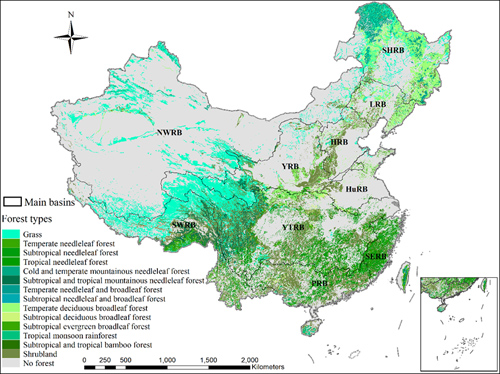Researchers Find Large Spatial Variations in Forest Water Retention Capacity in China
Under a scenario of global climate change and terrestrial water storage depletion, forest water retention, including the interception and storage of precipitation, regulation of runoff and purification of water, has become a focus of studies on ecosystem services.
Prof. SHI Wenjiao and TAO Fulu’s team at Institute of Geographic Sciences and Natural Resources Research of Chinese Academy of Sciences found large spatial variations in the canopy interception capacity (CIC), litter maximum water-holding capacity (LWHC), soil water storage capacity (SSC) and forest water retention capacity (WRC) in different forest types and soil types at the national and basin scales. Moreover, the effects of some factors such as location, terrain and canopy structure on the CIC, LWHC, SSC and WRC values were significant in only certain basins, but these effects were not significant throughout China. This work was published in Ecological Indicators.
Using a meta-analysis method systematically review the peer-reviewed literatures, the team collected the parameters of canopy interception, litter water-holding, soil storage and water retention and their influencing factors at multiple observation sites throughout China, a total of 1045 observation in this research. They applied a relatively comprehensive method - an empirical model of the WRC, to estimate water retention based on observation data and the water retention capacity.
The CIC, SSC and WRC decreased from south to north in China, which was opposite to the trend of LWHC. Under the guidance of Prof. SHI Wenjiao and TAO Fulu, graduate student WU Xi found that the average CIC (LWHC) values of the different forest types (tropical monsoon rainforest, subtropical needleleaf forest, subtropical deciduous broadleaf forest) and soil types (ferralsol, anthrosol and primarosols) distributed in southern China were approximately two (1/2) times higher (lower) than those of the forest types (cold and temperate mountainous needleleaf forest, temperate deciduous broadleaf forest) and soil types (semi-alfisol, pedocal and semi-hydromorphic soil) in northern China. The SSC values contributed approximately 60–85% to the WRC values in the different basins, soil types and forest types in China.
“The Pearson correlation coefficient (R) and path analysis were used to assess the impacts of climatic factors, terrain factors, location factors, forest types, and soil types, as well as canopy, litter and soil characteristics on the CIC, LWHC, SSC and WRC, and to determine the significant direct and indirect pathways through which factors affected the CIC, LWHC, SSC and WRC,” Prof. Shi said.
The researchers found that the effects of some factors such as location, terrain and canopy structure on the CIC, LWHC, SSC and WRC values were significant in only certain basins, but these effects were not significant throughout China. The indirect effects of some climatic, location and terrain factors on the CIC, LWHC, SSC and WRC values determined the total effects.
The work was supported by the National Key Research and Development Program of China.
 |
|
Figure: The distributions of forest types in China(Image by Prof. SHI Wenjiao and TAO Fulu’s group) |
Reference:
Wu Xi, Shi Wenjiao, Guo Bin, Tao Fulu. Large spatial variations in the distributions of and factors affecting forest water retention capacity in China. Ecological Indicators, 2020. 113: 106152. DOI: 10.1016/j.ecolind.2020.106152.
Download attachments: